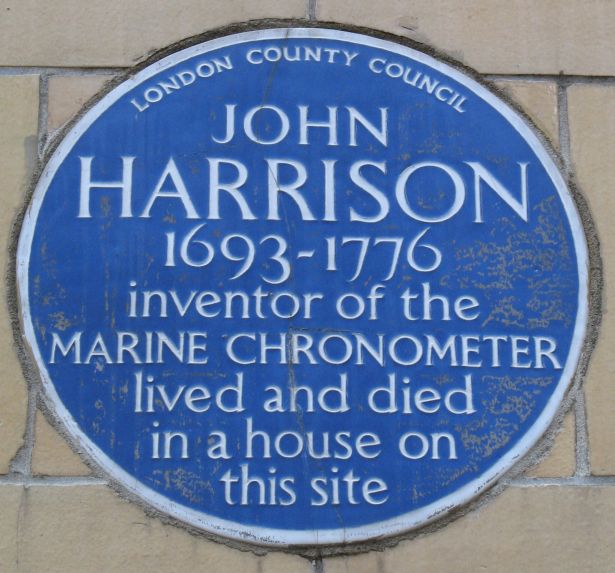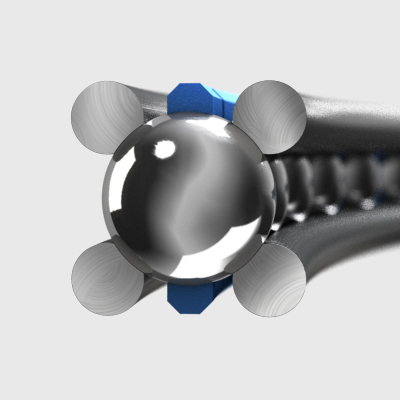|
Ball-bearing
A ball bearing is a type of rolling-element bearing that uses balls to maintain the separation between the bearing races. The purpose of a ball bearing is to reduce rotational friction and support radial and axial loads. It achieves this by using at least two races to contain the balls and transmit the loads through the balls. In most applications, one race is stationary and the other is attached to the rotating assembly (e.g., a hub or shaft). As one of the bearing races rotates it causes the balls to rotate as well. Because the balls are rolling, they have a much lower coefficient of friction than if two flat surfaces were sliding against each other. Ball bearings tend to have lower load capacity for their size than other kinds of rolling-element bearings due to the smaller contact area between the balls and races. However, they can tolerate some misalignment of the inner and outer races. Common ball bearing designs include ''angular contact, axial, deep-groove,'' and ... [...More Info...] [...Related Items...] OR: [Wikipedia] [Google] [Baidu] |
Bearing (mechanical)
A ball bearing A bearing is a machine element that constrains relative motion to only the desired motion and reduces friction between moving parts. The design of the bearing may, for example, provide for free linear movement of the moving part or for free rotation around a fixed axis; or, it may prevent a motion by controlling the vectors of normal forces that bear on the moving parts. Most bearings facilitate the desired motion by minimizing friction. Bearings are classified broadly according to the type of operation, the motions allowed, or the directions of the loads (forces) applied to the parts. The term "bearing" is derived from the verb " to bear"; a bearing being a machine element that allows one part to bear (i.e., to support) another. The simplest bearings are bearing surfaces, cut or formed into a part, with varying degrees of control over the form, size, roughness, and location of the surface. Other bearings are separate devices installed into a machine or mach ... [...More Info...] [...Related Items...] OR: [Wikipedia] [Google] [Baidu] |
Rolling-element Bearing
In mechanical engineering, a rolling-element bearing, also known as a rolling bearing,ISO 15 is a bearing (mechanical), bearing which carries a load by placing rolling elements (such as balls, cylinders, or cones) between two concentric, Groove (engineering), grooved rings called Race (bearing), races. The relative motion of the races causes the rolling elements to rolling, roll with very little rolling resistance and with little sliding (motion), sliding. One of the earliest and best-known rolling-element bearings is a set of logs laid on the ground with a large stone block on top. As the stone is pulled, the logs roll along the ground with little sliding friction. As each log comes out the back, it is moved to the front where the block then rolls onto it. It is possible to imitate such a bearing by placing several pens or pencils on a table and placing an item on top of them. See "bearing (mechanical), bearings" for more on the historical development of bearings. A rolling el ... [...More Info...] [...Related Items...] OR: [Wikipedia] [Google] [Baidu] |
Chrome Steel
Chrome steel is the name for any one of a class of non-stainless steels such as AISI 52100, SUJ2, 100Cr6, En31, 100C6, and DIN 5401 which are used for applications such as bearings, tools, drills and utensils. Like stainless steel, chrome steels contain chromium, but do not have the corrosion-resistant properties of stainless steel. It has been made from ferrochrome Ferrochrome or ferrochromium (FeCr) is a type of ferroalloy, that is, an alloy of chromium and iron, generally containing 50 to 70% chromium by weight. Ferrochrome is produced by electric arc carbothermic reduction of chromite. Most of the glo ... since it was developed around 1877 by J. B. Boussingault and of Jacob Holtzer steelworks in Unieux, France. References {{Authority control Steels ... [...More Info...] [...Related Items...] OR: [Wikipedia] [Google] [Baidu] |
Bearing Spacer Proper Length - Inline Skate Wheel Assembly - With Labels
Bearing(s) may refer to: * Bearing (angle), a term for direction * Bearing (mechanical), a component that separates moving parts and takes a load * Bridge bearing, a component separating a bridge pier and deck * Bearing BTS Station in Bangkok * ''Bearings'' (album), by Ronnie Montrose in 2000 See also * Posture (other) * Bering (other) Bering may refer to: * Vitus Bering (1681–1741), Danish-born Russian explorer and navigator * Maritime features of Alaska/Siberia region: ** Bering Sea, body of water in the North Pacific Ocean ** Bering Strait, sea strait between Russia and Alas ... * Baring (other) {{disambiguation ... [...More Info...] [...Related Items...] OR: [Wikipedia] [Google] [Baidu] |
Longitude (book)
''Longitude: The True Story of a Lone Genius Who Solved the Greatest Scientific Problem of His Time'' is a 1995 best-selling book by Dava Sobel about John Harrison, an 18th-century clockmaker who created the first clock ( chronometer) sufficiently accurate to be used to determine longitude at sea—an important development in navigation. The book was made into a television series entitled ''Longitude''. In 1998, ''The Illustrated Longitude'' was published, supplementing the earlier text with 180 images of characters, events, instruments, maps and publications. Problem of longitude Determining longitude on land was fairly easy compared to the task at sea. A stable surface to work from, known coordinates to refer to, a sheltered environment for the unstable chronometers of the day, and the ability to repeat determinations over time made for great accuracy. For calculating longitude at sea however, early ocean navigators had to rely on dead reckoning, or if in sight of land, coasta ... [...More Info...] [...Related Items...] OR: [Wikipedia] [Google] [Baidu] |
John Harrison
John Harrison ( – 24 March 1776) was an English carpenter and clockmaker who invented the marine chronometer, a long-sought-after device for solving the History of longitude, problem of how to calculate longitude while at sea. Harrison's solution revolutionized navigation and greatly increased the safety of long-distance sea travel. The problem he solved had been considered so important following the Scilly naval disaster of 1707 that the Parliament of Great Britain, British Parliament was offering financial rewards of up to £20,000 (equivalent to £ in ) under the 1714 Longitude Act, though Harrison never received the full reward due to political rivalries. He presented his first design in 1730, and worked over many years on improved designs, making several advances in time-keeping technology, finally turning to what were called sea watches. Harrison gained support from the Board of Longitude, Longitude Board in building and testing his designs. Towards the end of his life, ... [...More Info...] [...Related Items...] OR: [Wikipedia] [Google] [Baidu] |
Wire Race Bearing
A wire race bearing is a rolling-element bearing, where the balls or rollers run on race (bearing), races resembling loops of wire. Roller bearings may use just two races, but ball bearings typically use three or four races. Wire race bearings can be large yet lightweight and with small profile and good precision. Wire races have little intrinsic structure and must be adequately supported by the bearing housing. Balls, rollers or even cross rollers are used as rolling elements. Due to the design wire race bearings are commonly called '4-point-contact' bearings.Decker/Kabus, Maschinenelemente, Funktion, Gestaltung und Berechnung, Page 422, Hanser, 15th Issue 2000, The first wire race bearing was invented in 1934 by Erich Franke, co-founder of Franke & Heydrich KG in Aalen, Germany (nowadays Franke GmbH). As a young design engineer of Carl Zeiss AG, Carl-Zeiss-Werke in Jena, Franke intended to design a very space-saving bearing for an optical device. The aim of his thoughts was ... [...More Info...] [...Related Items...] OR: [Wikipedia] [Google] [Baidu] |
Robert Conrad (inventor)
Robert Conrad (born Conrad Robert Falk; March 1, 1935 – February 8, 2020) was an American film and television actor, singer, and stuntman. He is best known for his role in the 1965–1969 television series ''The Wild Wild West'', playing the sophisticated Secret Service agent James T. West. He also portrayed private investigator Tom Lopaka in ''Hawaiian Eye'' (1959–1963) and World War II ace Pappy Boyington in ''Baa Baa Black Sheep'' (1976–1978; later syndicated as ''Black Sheep Squadron''). In addition to acting, he was a singer and recorded several pop/rock songs in the late 1950s and early 1960s as Bob Conrad. He hosted a weekly two-hour national radio show (''The PM Show with Robert Conrad'') on CRN Digital Talk Radio beginning in 2008. Early life Conrad was born Conrad Robert Falk in Chicago. His father, Leonard Henry Falk, was 17 years old at the time of Conrad's birth and was of German descent. His mother, Alice Jacqueline Hartman (daughter of Conrad and H ... [...More Info...] [...Related Items...] OR: [Wikipedia] [Google] [Baidu] |
Ball Bearing Self Aligning
A ball is a round object (usually spherical, but sometimes ovoid) with several uses. It is used in ball games, where the play of the game follows the state of the ball as it is hit, kicked or thrown by players. Balls can also be used for simpler activities, such as catch or juggling. Balls made from hard-wearing materials are used in engineering applications to provide very low friction bearings, known as ball bearings. Black-powder weapons use stone and metal balls as projectiles. Although many types of balls are today made from rubber, this form was unknown outside the Americas until after the voyages of Columbus. The Spanish were the first Europeans to see the bouncing rubber balls (although solid and not inflated) which were employed most notably in the Mesoamerican ballgame. Balls used in various sports in other parts of the world prior to Columbus were made from other materials such as animal bladders or skins, stuffed with various materials. As balls are one of the m ... [...More Info...] [...Related Items...] OR: [Wikipedia] [Google] [Baidu] |
Run-out
Run-out or runout is an inaccuracy of rotating mechanical systems, specifically that the tool or shaft does not rotate exactly in line with the main axis. For example; when drilling, run-out will result in a larger hole than the drill's nominal diameter due to the drill being rotated eccentrically (off axis instead of in line). In the case of bearings, run-out will cause vibration of the machine and increased loads on the bearings. Run-out is dynamic and cannot be compensated. If a rotating component, such as a drill chuck, does not hold the drill centrally, then as it rotates the rotating drill will turn about a secondary axis. Absolute alignment is impossible; a degree of error will always be present. Types Run-out has two main forms: * ''Radial run-out'' is caused by the tool being translated off the machine axis, still parallel. Radial run-out will measure the same all along the machine axis. * '' Axial run-out'' is caused by the tool or component being at an a ... [...More Info...] [...Related Items...] OR: [Wikipedia] [Google] [Baidu] |







